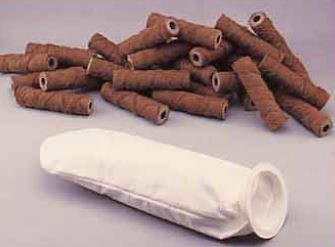
1. COST – The cost of replacing the filter media is one aspect; others include frequency of replacement and waste disposal cost. The frequency of replacement addresses not only the annual units of media to be purchased but also the number of interactions personnel have accessing the vessel and exposing themselves to the fluid, so it involves labor and safety costs. Although it depends upon the specific filter bag, filter cartridges typically cost at least twice as much as filter bags for a given flow rate especially because multiple cartridges are required per filter bag for a given flow rate.
2. Flexibility – Bag filter vessels have the space to insert magnetic assemblies to help remove magnetic material and reduce the clogging rate of the filter bag. We use powerful 9300 gauss magnets encased in 316SS and placed into a holder that sits within the filter bag.
3. Disposal – While filter cartridges have less potential for retained fluid, the volume of cartridges to dispose of can be substantially more when compared to fewer filter bags. Using a #2 size bag filter vessel as an example for a 100 GPM application, it would require (5) 30″ long cartridges, thus five times the number of cartridges are disposed of compared to just 1 filter bag and this directly effects your waste disposal costs. In addition, if incineration is used for disposal you will discover that filter bags dry out better than a saturated and dense filter cartridge.
4. Viscosity – For viscosities >50cP tend to favor filter bags due to their larger surface area (especially pleated designs), which would otherwise require many more cartridges. Likewise, for high flow rate applications the number of filter cartridges required becomes impractical.
5. Complexity – Since the sealing of cartridge filter assemblies is more complex (requiring washers, nuts and sealing plates) replacing them can be a tedious procedure. When compared to a single filter bag system, the vessel-cleaning step is not necessary and thus there is less fluid disposal. There are also no nuts/washers involved and no tools are required at all to swap-out a filter bag and therefore typically the time spent for each change-out is ½ what the cartridge system requires. If you invest in more expensive, high particle loading filter bag designs, the frequency of change-outs would be less, maximizing the reduction in labor.
6. Reduced Contamination – When a filter bag is removed from the vessel the likelihood of particles bypassing the filter media is reduced because there are only two sealing points, between the restrainer (support) basket/housing and between the bag/restrainer basket. Thus, the retained particles fall into the filter bag, so when it is removed all the particles are removed with it. Conversely, the flow path for filter cartridges is from the outside to the inside, so when removed from the vessel, the discharge port is exposed to the filter vessel area that was exposed to the unfiltered fluid, hence there is an increased chance of particle bypass. Often multiple cartridges are required per vessel thus the number of sealing points can be significantly more when compared to a bag filter system. A thorough cleaning of the vessel prior to installing the replacement cartridges reduces potential for such cross contamination, but such additional labor & time should be factored into the overall operating cost of the filter system.
